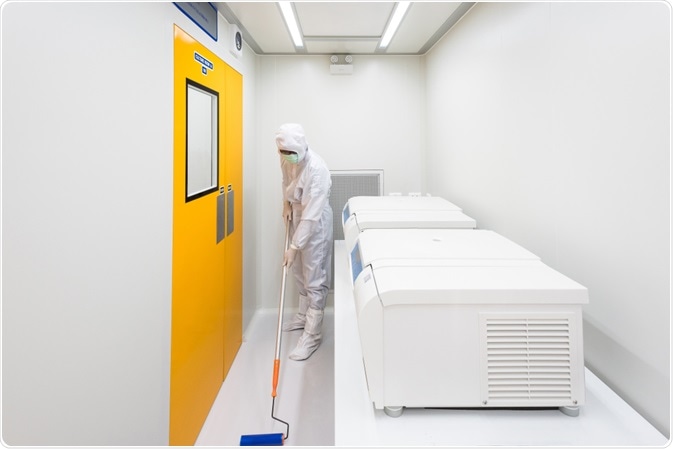Cleanrooms are designated areas wherein the concentration of contaminants and microorganisms is controlled by using various methods. These rooms are typically used for the during manufacturing of a specific product or for healthcare-related reasons such as surgical procedures. A range of techniques can be employed to maintain aseptic conditions.
 warut pothikit | Shutterstock
warut pothikit | Shutterstock
Controlling environmental contaminants
A cleanroom should be a controlled area with minimal contamination of surface and air. The environment is encased with surfaces, such as Lexan and/or stainless steel. These surfaces can be easily cleaned and are resistant to scratches.
The latter is of utmost importance, as scratches can be a hiding area for microorganisms. These environments often have high-efficiency particulate (HEPA) filters that can remove around 99.9% of microorganisms. This is done by a continuous filtration process and air that moves with high velocity through the filter, in turn, reducing the burden of bacteria.
Protective clothing
PPC, of personal protective clothing, primarily refers to the clothes worn by personnel while aseptic techniques are being used. These include gloves, socks, sleeves, hoods, masks, glasses, goggles, suits, aprons, lab coats, scrubs, etc.
Clothing is specified by standard operating procedures (SOPs) that are read by every person who enters the cleanroom. The procedures should also explicitly state the frequency of changes and the exact sequence of clothing for the specific process.
Contact tryptic soy agar (TSA) plates may be used to test hands, shoulder, and forearms after wearing PPC. Apart from maintaining the aforementioned standards, such certification process also shows a level of competency to the regulators.
Hand washing also constitutes an important part of the personal gowning process. More specifically, all the jewellery, watches and bracelets should be removed before cleansing. After washing, gloves should be worn immediately; moreover, gloves should also be frequently sanitized using 70% alcohol.
Visual inspection
The work area, clothing, equipment, IV bags, and needles can be continually inspected by pharmacists and technicians to ensure there is no clutter, debris, vial defects, trash, or the disposable packaging left in the cleanroom.
If a breach is discovered, the defective item should be removed and the area should be re-sanitized. Similarly, the presence of precipitate, flakes and/or dust can also indicate potential breach and hazards in the area. The need for such visual inspection should be emphasized during hiring training and recruitment of personnel to work in the cleanroom space.
Cleaning and sanitization
It is very important to disinfect the cleaning area daily. This cleaning process should be documented in datasheets and logbooks to demonstrate that the standards are being followed. The utilization of 70% isopropyl alcohol is an easy and effective choice for sanitization, as it is efficacious against most grambacteria. Using a second sanitiser, such as hydrogen peroxide, peracetic acid or quaternary ammonium can bring higher efficiency to the overall cleaning process.
Procedural manipulation
Procedural manipulation refers to the preciseness during the cleaning procedure. This include manipulation that can minimize contact with potential sources of contaminants, such as needles.
As soon as a contact is made, the surface should be wiped with 70% alcohol. The movement should also be limited and movement induces particle generation and potential of contamination. The process of procedural manipulation can be shown using media proficiency testing.
Disposal and cleanup
Disposal and cleanup of a cleanroom area after a procedure is done represents a crucial step to maintain its integrity. Any spillage should be wiped to avoid potential safety and contamination hazard. If a person is moving out of the sterile area, re-sanitization is required prior to their return.. Finally, the materials that have been spent should be properly disposed and the area should be resanitized before leaving.
Further Reading
Last Updated: Feb 25, 2023